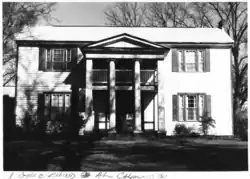Greenwood | |
 | |
| Location | Alexandria, Calhoun County, Alabama, U.S. |
|---|---|
| Coordinates | 33°46′21″N 85°52′48″W / 33.7725°N 85.88°W |
| Built | 1842–1850 |
| Architectural style | Greek Revival |
| NRHP reference No. | 89000162 |
| Significant dates | |
| Added to NRHP | March 9, 1989 |
| Designated ARLH | April 23, 1987 |
Greenwood, also known as the Green–Woodruff House (built 1842–1850), is a historic Antebellum plantation house in Alexandria, Alabama, U.S..[1] It was once part of the Greenwood Plantation, which had been worked by enslaved people.[2][3] Some six generations of the Green–Woodruff family owned the house.[3]
It is listed on the National Register of Historic Places since March 9, 1989 for the architecture;[1] and is listed on the Alabama Register of Landmarks and Heritage since April 23, 1987.[4] Greenwood also has a historical marker.[2]
Architecture

Greenwood is an example of a rural Alabama vernacular domestic building, displaying Greek Revival architectural details.[3][5] The architect is unknown.[1] The two story building was built starting in 1842, and contains four columns (two Doric and two Ionic).[3][5] The house exhibits the traditional I-house form: two rooms high and one room deep with a tall and narrow profile.[3] It includes an intricate portico in the Greek Revival style.[3] This style of house in mid-nineteenth-century Alabama was common practice for the design and construction of plantation houses.[3]
In 1850, the house construction was completed.[3]
History
The house was built for Jacob Ross Green (1810–c. 1875) from South Carolina.[3] Around 1820, his family moved to St. Clair County, Alabama.[3] In 1831, Jacob Ross Green married Elizabeth Boyd, the daughter of Judge Samuel Boyd, and soon began acquiring land in the newly established county of Benton (later renamed Calhoun County).[3] Under the Treaty of Cusseta in 1832, the United States Government acquired the entire Creek Nation land holdings, which included lands in northeast Alabama.[3] Upon petition, land patents were issued to the White settlers many of whom had recently moved to the area.[3] On April 25, 1842, O. E. Burt sold to Jacob Ross Green 150 acres (61 ha) of land and it was on the tract he built his home known as Greenwood.[3] He farmed the land and became successful, and by 1844 he had owned eleven enslaved people.[3]
Jacob Green had five children, including Samuel LaFayette Green Sr., the next owner of Greenwood starting in 1865.[3] In 1913, his son S. L. Green Jr. acquired the property.[3] Greenwood stayed in the Green family until 1916, when it was sold to his son-in-law Norris Woodruff.[3]
Woodruff lived at Greenwood for nearly 23 years, until his death in 1939.[3] Woodruff's eldest son, Wallace Green Woodruff acquired the house after his father's death from his many siblings.[3] After his death in 1963, his son Wallace G. Woodruff Jr. acquired the house, and when he died, his five children inherited the house.[3]
Reportedly haunted
The house is said to be haunted by a former nanny named Ms. Polk, affectionately referred to by the family as Ms. Pokey, who died in the 1920s while sitting at the bottom of the house's staircase.[2]
See also
References
- 1 2 3 "Greenwood". NPGallery, Digital Asset Management System.
- 1 2 3 McCreless, Patrick (October 8, 2017). "Historical marker added to 175-year-old Alexandria home". The Anniston Star. Retrieved October 4, 2023.
- 1 2 3 4 5 6 7 8 9 10 11 12 13 14 15 16 17 18 19 20 21 "National Register of Historic Places Inventory/Nomination: Greenwood". National Park Service. Retrieved October 3, 2023. With accompanying pictures
- ↑ "The Alabama Register of Landmarks & Heritage" (PDF). preserveala.org. Alabama Historical Commission. August 20, 2018. Archived (PDF) from the original on October 9, 2018.
- 1 2 Folsom, Hervey (August 21, 2022). "A walk through the Greenwood Antebellum Home in Alexandria". The Anniston Star. Retrieved October 4, 2023.
![]() This article incorporates public domain material from websites or documents of the National Park Service.
This article incorporates public domain material from websites or documents of the National Park Service.